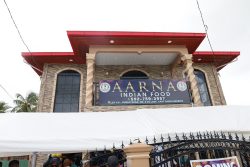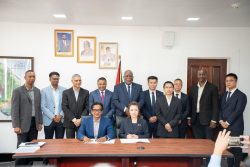Launching a $1.6B credit facility, Agriculture Minister Robert Persaud yesterday said rice producers should not squander the funds loaned to them as happened in the past or use the credit facility to re-finance outstanding debts.
Persaud issued this call while addressing rice sector stakeholders and dignitaries at the launching of a financial credit facility to assist rice farmers hosted at the Guyana Bank for Trade and Industry (GBTI) Recreational Centre in Bel Air Park.
The facility is a component of the European Union Rice Competitiveness Programme established to address issues of financing for rice producers, processors, input suppliers and other stakeholders.
The minister stated that the government expects there would be a high degree of transparency and competitiveness resulting in viable and employment-generating projects.
Persaud referred to the credit facility as a booster shot for the industry saying that it would serve as an impetus to drive production and re-investment, which are needed to enhance competitiveness and ensure sustainability in the rice sector.
Giving a historical background to the rice sector, the minister highlighted a 50% reduction of prices as a result of safeguards implemented by Europe from January 1997.
He noted that prior to the implementation of import safeguards the European Union was absorbing some 90% of Guyana’s exports, while the default payment rate from the rice sector was the highest in the banking industry. Banks therefore lost confidence in the rice sector and many farmers and millers went into bankruptcy and there were bank-foreclosures, suicides, broken homes and other social ills.
As a result government intervened by working out a restructuring formula to make the sector competitive. This, he said, came into effect in 2003/2004 and consequently loans have been restructured resulting in renewed confidence at both the production and support service levels
The floods saw government making adjustments to the Financial Institutions Act (FIA) so farmers could access better loan-servicing arrangements. Additionally the Guyana Rice Development Board (GRDB) is being reorganized to better serve the sector along with the amendment to the Rice Factories Act to ensure farmers and the industry are protected through prompt payment.
President Bharrat Jagdeo was personally involved in having the facility realized in Guyana after it appeared that the banks were reluctant to administer it. The government remained committed to the development of the sector, Persaud said, because of its role in socio-economic development, rural poverty alleviation and national and regional food security.
Lower interest rates
Minister Persaud also acknowledged that interest rates under the facility are much lower and more accessible to beneficiaries when compared with normal agricultural loans. The interest rates for loans under the programme amount to some six to eleven percent. This, he said, is useful in the absence of direct agricultural development financing.
The model, he noted, could possibly be employed regionally although the country had experienced consequential nightmares during an earlier era when such a bank was in existence. The minister also urged the millers and exporters to form an association through which they could source markets instead of having the GRDB do that for them.
Director of CARIFORUM Percival Marie stated that the EU provided some 24M euros for the region with 40% of that sum being earmarked for financing. This meant that 10M euros was divided between Suriname and Guyana with Guyana receiving 6M euros.
The funds were made available to assist the industry with difficulties it was experiencing at the time though it is not normal for the EC to provide such resources, Marie said. As a result, he noted, they experienced some difficulties because no precedent was available. A new system had to be designed to cater for development of the credit facility.
The Government of Guyana, he recalled, stepped in to provide a state guarantee to pass the resources through the bank. The primary provisions of the facility would be working capital and capital investments.
The contract was signed between CARIFORUM and GBTI and endorsed by the EU, Marie said, adding that the documents for transfer of the first tranche of the facility were just signed.
CARIFORUM or the Caribbean Forum of African, Caribbean and Pacific (ACP) states is a grouping of 15 Caribbean countries which are signatories to the Lome IV Convention. The Forum’s primary objective is to coordinate the allocation and undertake the monitoring of resources from the European Development Fund (EDF) for the purpose of financing regional projects in the Caribbean.
Symbiotic
relationships
Marie said some of the accompanying facilities included 1M euros for the GRDB and technical exports to assist GBTI with aspects of the programme such as improvement of production at local mills.
Radhakrishna Sharma, Chief Executive Officer of GBTI, noted that farmers could use the loans for machinery and equipment, millers to expand facilities and importers to source fertilisers. In this vein he emphasized a need to create symbiotic relationships to improve existing systems.
He urged millers and rice producers to work toward making out contracts rather that just buying and selling to allow for more compliance between the parties. Sharma voiced his anticipation of a greater role for the GRDB, Ministry of Agriculture and the Guyana Rice Producers Association (GRPA). He also asked that borrowers honour their loans, especially at the interest rates being offered.
Charge d’Affaires of the Delegation of the European Commission Helen Jenkinson said she is close to the project because it was one of the first she began working on upon arriving in Guyana.
The question, she said, of the EU getting involved in micro-credit posed some challenges as the system was geared towards macro financing. However since the programme has been worked out here the EC has again started working with micro-finance.
She said that European leaders were also concerned and were provided with detailed reports on the feasibility of the programme. She pointed out that provision of the facility was based on sound financial judgement.
‘Eat Guyana rice’ campaign
She suggested, too, that farmers find ways of benefiting from the regional component of the programme as well as selling rice in Latin America since the facility was given with the idea that it would result in higher rice sales. She also suggested that producers get involved in an ‘Eat Guyana rice’ campaign to gain some mileage as some 12,000 visitors are expected to descend on Guyana for World Cup Cricket.








